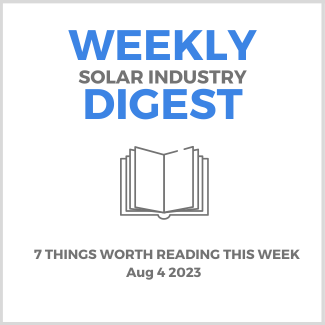Manufacturing of project subcomponents like junction boxes, backsheets, and solar cell laminates is getting a boost in the wake of increased domestic manufacturing from the impact of the IRA. Companies like Vitro, New Energy, and Hanwha are enjoying the increased demand and signing deals that expand their distribution.
Last week FERC made a new ruling that is expected to drastically speed up the interconnection process. Grid operators and electric utilities must change how they study energy projects and will be subject to firm deadlines and penalties. Projects must be studied in groups and projects further along in development will be prioritized. It also requires project developers to submit financial deposits and get certain land or building rights to reach approval.
This article discusses the impact of surveying tech advances on the solar market. It looks at developments like the fact that engineering firms are increasingly using drones that tap the latest LiDAR and global positioning systems in order to drastically speed up data collection. For example, the latest drone tech allows surveyors to program a drone to follow a specific flight path and complete the surveying task autonomously, something that drastically cuts down on project time.
White House’s Council on Environmental Quality has proposed reforms to speed up clean energy permitting on federal land. It also sets deadlines for environmental reviews and directs agencies to include environmental justice in their considerations.
SPW lays out the arguments presented to Commerce at the July 18 hearings as they prep to make a final decision Aug 17. Auxin: any Chinese component — all the way back to polysilicon — must be forced under the tariffs and no companies excluded. Anti-tariff side: damage to manufacturing will be extensive (Silfab spoke of no functioning US silicon cell producers at the moment means relying on imported solar cells, which are largely from Southeast Asia), and excluded companies are able to thrive, and the wafer-forward ruling is profoundly erroneous.
In this new video series Bonnano and Kerim Baran interview MIT professor and Climate Change AI (CCAI) co-founder PriyavDonti regarding generative AI and machine learning. The trio look at what they are, how they evolved, approaches to current applications as well as where they are currently used with high impact. In this first of the ten-part series (and second portion of the 3 part series) they kick things off by discussing using AI solutions to address climate issues in the business sector. The video is below.
In this video series Bonnano and Kerim Baran interview MIT professor and Climate Change AI (CCAI) co-founder PriyavDonti regarding generative AI and machine learning. In this second of the ten-part series (and second portion of the 3 part series) they explore the synergy between machine learning and artificial intelligence, delving into their relationship and various applications. The video is below.

